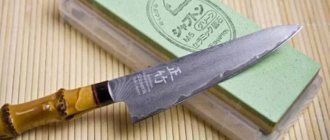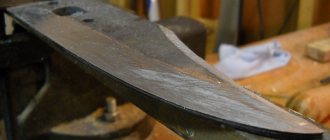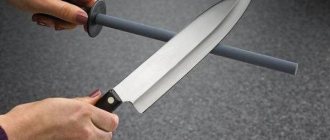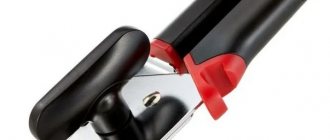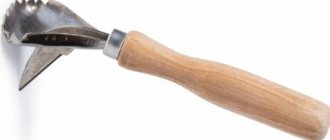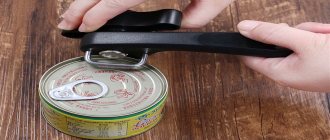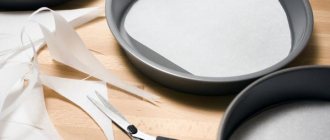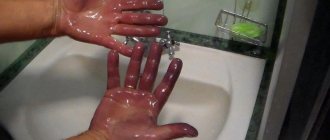Musat is a sharpening tool that is used both by professionals and at home. With its help, you can sharpen knives, straighten blades, and can be used daily without damaging the metal of the cutting tool. There are diamond, ceramic and steel musats; each type has individual advantages and some disadvantages.
The cost of musats ranges from 100-5000 thousand rubles; ceramic ones are considered the most expensive. You can make a tool yourself (from an electrode), but experts say that this is not advisable - the sharpening quality is low and the service life is short.
What is musat, what is it for?
Musat is a special device that is used for straightening knives; it is needed to keep the edge of the blade always sharp. It is an imitation of a round file with a handle. The main feature of musat is that when editing a knife, shavings are not removed from the metal, the surface of the blade remains unchanged, which extends the life of the cutting tool. It is important that the hardness of the metal of the sharpening tool exceeds that of the knife.
Knife musats, depending on the area of use, are divided into three large groups:
| Household | These are the cheapest tools, having a length of only 180-230 mm. Used for sharpening ordinary kitchen knives, which have a “soft” blade metal. |
| Universal | Much better in quality and more expensive than household ones, they have a “rod” length of 260-290 mm. Excellent for working with hard blades. |
| Professional | Their main difference is their size: the length of the “rod” is 260-360 mm. If you need to prepare a knife for cutting meat, then you should use thin musat, the length of which is 320-360 mm. Professional chefs prefer a tool with a thicker “rod” (260 mm). |
Musat device
Yes, it looks like a file and is essentially the same. Only the file is designed for longitudinal movements along the tool, but with the musat, on the contrary, we move the knife along it with transverse movements. On the round surface of the working rod there are longitudinal notches, to which the cutting edge of the knife is applied. On one side the musat has a handle, on the other there is a slightly pointed core, which can be reliably rested on a horizontal plane. To increase the safety and comfort of work, it is desirable that the design of the grinder include a guard between the handle and the working part, that is, a limiter that protects the hand when moving the knife.
When choosing musat for purchase, it is advisable to clarify the hardness characteristics of the steel grades from which it is made and the knives that will be sharpened. Musata steel, naturally, must exceed the hardness of knife steel. It is also necessary to correctly take into account the size of the musat rod: the longer the blade of the dressing knives, the longer the working part should be.
Types of musat for knives by material
When buying polish for knives, you should pay attention to the material from which it is made:
- ceramics;
- metal;
- diamond.
Depending on this parameter, the sharpening tool is used to work with different types of knives.
Ceramic
This kind of knife polish has a ceramic coating of different abrasiveness on the “rod” - on one side there are notches on the surface, on the other it is absolutely smooth. The first option is necessary for sharpening the blade, to give a sharp edge to the blade. But a smooth ceramic coating will be needed for finishing straightening the metal.
Ceramic musat is optimally suited for working with knives of low metal hardness. It should also be used for straightening wide blades and old, “worn out” cutting tools.
Ceramic musat
Diamond
Diamond musat is recognized as the best sharpening tool, because just a few movements are enough and even the hardest/largest knife will become sharp again. A tool with a diamond “rod” is not used for sharpening the blade; it can only be used to straighten and polish the metal.
Diamond musat is made from chrome-plated steel, with diamond particles sprayed on top. The tool is produced in an oval shape, which prevents the formation of nicks on the surface.
It is important to properly care for this type of musat:
- Be sure to rinse by hand under running water after use;
- dry naturally (do not wipe with a towel);
- Store separately from any solid objects.
Diamond musat
Steel, metal
Steel nuts are made from an alloy of chromium and vanadium; the main advantage of a metal tool is the maximum hardness of the “rod”. The surface is smooth, the tool is necessary for straightening and polishing the blade, but is never used as a sharpening device.
There are no special features in caring for metal musat; it is quite simple to keep it clean.
Fischer Éco round steel nut, chrome plated
Mixed
A mixed sharpening tool is one that has different surfaces: one smooth, the other with fine serrations. This musat can be used to sharpen, sharpen, and polish knives.
Types of devices by shape
Products may have different cross-sectional shapes. Possible options:
- Round. The tool is lightweight.
- Oval. More convenient to use, have greater contact with the surface of the knife.
- Faceted. There are flat, tetrahedral and D-shaped. In the first case, linear contact with the blade is ensured; in the second and third cases, special sharpening is carried out due to the combination of the functions of a flat and volumetric tool.
There is also a tabletop V-shaped musat. It consists of 2 rods that are installed on the base at the desired angle.
Musat with a round cross-section.
Musat with an oval cross-section.
Flat Musat.
D-shaped section of musat. Tabletop V-shaped grinder.
What types of musats are there for sharpening knives by function?
Musats are used not only for sharpening knives, but also for polishing them. Moreover, the industry produces two types of tools, which differ in their functional “accessories”.
For grinding
Grinding musk can be:
- tubular;
- round;
- flat.
Forms of musats
The tool is used even for new knives, because the edge of the blade is not brought to perfection in production. Grinding musat is optimal for straightening kitchen knives whose sharpness level has simply decreased a little. It is impossible to fully sharpen a cutting tool with this type of device.
For initial sharpening
The most popular musats are those that are made of metal and have notches on their surface. The shape of the tool can be absolutely any, it is chosen individually - who is comfortable working with what.
For initial sharpening of knives, it is best to use a classic round steel grinder, the length of which ranges from 250-300 mm. It must be taken into account that this parameter should always be 50 mm greater than the length of the blade of the knife that needs to be sharpened.
Watch the video on how to sharpen a knife using musat:
How to use musat: first method
You can sharpen products directly on the weight, or you can also rest the tool on some object. In the first case, we place the heel of the knife on the upper end of the musat, and we turn the blade towards ourselves and move it along the tool towards ourselves. The musat contains a restrictive guard that will protect the hand.
The angle between the knives and the musats should be about twenty degrees. During the process, do not press hard on the cutting object, but press lightly. Then we place the musat over the knife, whose heel is pressed against the end of the musat. We pull the knife towards ourselves, maintaining an angle of twenty degrees. It is enough to treat a slightly dull blade three to four times. In other cases it will take longer.
To test the sharpness of a knife, cut a piece of newspaper. If it cuts the paper smoothly and doesn't snag, it's ready to use. After editing, we wash both the knife and the grinding cloth, and wipe the products dry. However, the method described above may seem too complicated for some, as it requires some skill. Therefore, below we offer an easier method.
How to sharpen knives with musat on weight
Sharpening a knife with musat while hanging is carried out according to the following algorithm:
- Take a knife in your hand and place its blade downwards at the bottom of the musat. The cutting edge at this moment should be in the “away” position.
- The blade moves towards itself along the surface of the tool. It is important to maintain the angle of inclination.
- Several repetitions of the movements are performed - quickly, but without pressure.
- Turn the knife over with the blade facing you and repeat the process.
It’s not easy to sharpen knives while hanging with musat, but this is exactly how professional chefs use the tool. For the process to proceed correctly, three rules must be followed:
- The angle of inclination of the musat in relation to the knife blade should be strictly 20 degrees.
- Back-and-forth movements are performed at a fast pace.
- Jerking and too sharp “jerks” are strictly not allowed.
This method of sharpening knives is considered dangerous because there is a high probability of the blade jumping off the surface of the grinder and injuring the hands, even the stomach. To make the cutting tool sharp, it is enough to repeat the movements 5-6 times for each side of the blade. If the knife is very dull, then the number of repetitions increases by one and a half to two times.
You can also sharpen a completely new knife while hanging, for which you can maintain an angle of inclination of the grinder of 30 degrees. In this case, the movements of the blade are performed with light pressure and in the direction “away from you.”
How to use with support
It is much easier to use a grinder with a support; the sharpening process in this case will proceed in a clear sequence:
- The sharpening tool rests strictly vertically on a hard surface. To prevent it from slipping, it is recommended to place a towel.
- Already at the stop you need to position the tool at an angle of 20-25 degrees.
- The knife blade moves along the surface of the musat strictly perpendicularly.
- They begin the movement from the top - the base of the knife is adjacent to the sharpening tool, and end at the bottom - the tip of the blade is adjacent to the sharpening tool.
It is important to make movements only in one direction - from top to bottom; to repeat, the knife blade comes off the surface of the “rod”.
How to edit a knife
You can and should sharpen knives with musat every day so that the blade always remains sharp. The process is performed according to the same algorithm as sharpening a tool with a support, but with one difference - the tip of the knife is applied to the right to the upper part of the “rod”. Next, a downward movement is made and repeated 4-5 times for each side.
You can simplify the process and position the sharpening tool not vertically, but horizontally, slightly lifting it above the surface by the handle. After finishing work on editing the knife, be sure to wipe its blade from metal chips.
Watch the video on how to sharpen a knife with musat:
How can you tell if a knife is sharp enough?
After sharpening, you must check whether the blade is sharpened well. To do this, you can use one of these methods:
- Select a strand of hair at the back of your head and press the knife against it at a right angle. Swipe through hair from top to bottom without making sudden movements. If the blade is still dull, it will slip off easily, whereas a sharpened point will stick.
- Take a newspaper or sheet of paper and hold it suspended. In this position, try cutting the sheets: if you succeed, the sharpened knife is already quite sharp.
For many cooks, musat has become an indispensable item in the kitchen. This is due to the fact that it is easy to use, it does not damage knife blades and lasts a very long time if used correctly.
How to choose musat for sharpening knives
You should choose musat for sharpening knives according to the clear recommendations of experts:
- if the coating of the “rod” is diamond, then no dust or small crumbs should fall off it - just rub it with your finger to ensure the quality of the tool;
- ceramic musat should not have visible damage - scratches, chips;
- High-quality steel models are distinguished by uniform metal density - there should be no roughness on the surface of the “rod”.
It is highly desirable that a magnet be “built-in” at the tip of the sharpening tool. This improvement of the grinding cloth ensures the collection of metal dust during sharpening or straightening of knives.
Which is better - ceramic or steel?
It is believed that between ceramic and steel musat it is better to choose the first option:
- ceramic coating is durable;
- working with knives does not damage the metal.
But steel musat also has an important advantage - it is resistant to falls and impacts, while ceramics are damaged very easily.
Which professional do you choose?
Professional grinders are distinguished by their size - the length of the entire tool does not exceed 260 mm. Chefs claim that the surface of the “rod” should be polished as much as possible in order to see one’s own reflection in it. This means that you should pay attention to metal and steel sharpening tools.
If the choice is made to use musat in a regular kitchen, then it will be especially convenient with a thin rod, because it will be easy for them to sharpen both narrow and wide knives of different shapes.
Musat storage
Having considered practically how to sharpen knives with musat, it remains to provide for the correct storage place for it. Placing it next to the knives, of course, would be more convenient, but it is not at all necessary to keep it in the kitchen. Since the musat takes up very little space in diameter, it can be easily placed in a drawer, hung on the wall (if there is a loop on the handle), placed in a desktop rack or block. The main thing is that the storage area remains dry, and the waste material itself is washed with warm water and a sponge with detergent before cleaning. We hope that now it has become completely clear to all amateur and professional chefs how to use musat correctly. Subscribe and read our useful workshops, reviews and research about everything related to kitchen knives in future publications!
How to properly care for a musat knife
The musat knife can be actively used for a long time, but for this you need to properly care for it:
- after use, the tool should be stored suspended - on a hook or in a special stand;
- You need to wash the musat with warm water, any detergent, but without abrasive particles in the composition;
- if the “rod” is diamond coated, then the tool should be stored separately from any other hard objects;
- Ceramic tools should not be dropped or knocked - even a small chip or shallow scratch makes it impossible to use the tool for its intended purpose.
The tool must be stored in a special stand
Rating of the best musats for knives for 2022
The review of quality options was compiled based on customer reviews of online kitchenware stores and the Yandex Market site. There are three categories based on the material used: ceramic, steel, diamond-coated.
Ceramic
5th place Musat ceramic blue Flugel (Solingen), 25 cm
Price - 2,500 rubles.
The product is made by a famous German company.
It is distinguished by a uniform blue color of the rod with a round cross-section.
The handle is black, plastic (polypropylene), rounded. There are four oblong indentations for ease of holding. The upper part of the handle is a special element with a through round hole for a steel ring.
Parameters (cm):
- working part length – 25;
- overall size – 38;
- ceramic diameter – 1.4.
Handle dimensions (mm): width – 3, length – 13.
Weight – 250 g. Grit – 800-1,000 grit.
Warranty period – 1 year.
Blue ceramic musat Flugel (Solingen), 25 cm
Advantages:
- unusual colors;
- long rod;
- high grain size;
- can be hung by a steel ring;
- comfortable to hold;
- guarantee period.
Flaws:
- high price.
4th place Shimomura ASS-228, ceramics, 21 cm, white
Price - 1,440 rubles.
Manufacturer: Japanese brand “Shimomura”.
It is distinguished by the white color of all parts and small size. The rod has a uniform size along its entire length, a circular cross-section, and parallel rectangular sides. The plastic handle is connected by a metal guard. There is an oval hole on the top for storage.
Dimensions (cm): total length – 21, rod – 12, diameter – 1, handle – 9. Weight – 100 g.
Grit size – 600 grit.
Shimomura ASS-228, ceramic, 21 cm, white
Advantages:
- compact dimensions;
- round, rectangular sides;
- plastic handle, large hole;
- quality material;
- spectacular look.
Flaws:
- the white color is quickly lost.
3rd place Hatamoto HD-1229C, black and white
Price - 1,480 rubles.
Product of the famous brand “Hatamoto” (Japan).
It has small parameters, a white rod, and a large plastic handle. The working surface is white zirconium ceramic, with a circular cross-section that is the same along its entire length. There are two sides: smooth, with notches.
The handle is black, plastic, with rounded shapes. There is a large hole in the top. The connecting guard has high sides.
Characteristics: working surface – 127 mm.
Grain size – ultra-fine.
Dimensions of the packaging blister (cm): length – 38, width – 11, height – 3. Weight – 0.125 kg.
Hatamoto HD-1229C, black and white
Advantages:
- quality material;
- two different sides;
- comfortable handle;
- wide guard;
- can be hung.
Flaws:
- small sizes.
2nd place Lansky 8″ Ceramic Sharp Stick LSS8CM, beige
Cost - 1,660 rubles.
Manufacturer: American.
It has a light wooden handle, a long cylindrical rod with a transverse notch, and a round cross-section.
The wooden handle has an oblong shape and smooth lines. Decorated with transverse lines of the upper and lower parts.
Parameters (mm): total length – 315, ceramic part – 205, diameter – 7.
Grit size – 600 grit.
Packaging: transparent plastic cylinder, red bottom, yellow top cap.
Lansky 8″ Ceramic Sharp Stick LSS8CM, beige
Advantages:
- comfortable to hold;
- beautiful view;
- Suitable for many types of blades;
- high-quality ceramics;
- transverse notch;
- popular options.
Flaws:
- no ring, no hole for hanging;
- Careful handling of the varnished surface of the wooden handle.
1 place Samura S-600, ceramics, 37.2 cm, white
Price - 2.376-2.720 rubles.
Manufacturer: Japanese brand Samura.
Has a black handle, white ceramic part.
The handle is plastic, round. The company logo is located in the middle of the side surface. There are smooth lines, a comfortable shape, and a top hole.
Dimensions (mm): ceramic part – 254, total length – 372, plastic handle – 118, width – 47, thickness – 23. Weight – 0.200 kg. Grit size – 600 grit.
Packaging parameters (mm): length – 434, width – 110, height – 5. Product weight in packaging – 231 g.
Suitable for metal materials with hardness 58-63 HRC.
Samura S-600, ceramics, 37.2 cm, white musat
Advantages:
- famous brand;
- laconic design;
- easy to hold;
- convenient to store due to a special hole;
- popular parameters;
- convenient packaging.
Flaws:
- high price.
Steel
5th place Wusthof Sharpening steel 4474/32, 32 cm, black
Cost - 4,990 rubles.
The manufacturer is a well-known German company.
Consists of a metal blade and a plastic handle. The blade is cylindrical in shape, with uniform notches. Places without notches near the handle, upper tip. The handle is black, elongated, with smooth edges and transitions. The brand logo is at the top. There is a folding steel ring.
Dimensions (mm): length – 320. Weight – 0.370 kg.
Sharpening angles: 15/20/25/30.
Wusthof Sharpening steel 4474/32, 32 cm, black musat
Advantages:
- high quality metal;
- comfortable to hold for a long time;
- easy to store;
- can be hung by a ring;
- famous brand.
Flaws:
- high price.
4th place TRAMONTINA Professional Master 24642/080, 25 cm, white
Cost - 1,200 rubles.
Manufacturer – popular (Brazil).
It features a light corrugated surface and a white handle. The handle is made of polycarbonate with fiberglass. The shape is elongated, connected to a guard. The metal ring is fixed at the top. Corrugated shaft on all surfaces except the shiny tip.
NSF (National Sanitation Foundation) certified.
Dimensions (cm): total length – 41.5, steel part – 25, diameter – 0.9, handle – 12.
Weight – 0.291 kg.
Sold in a branded cardboard blister on the core of the product.
TRAMONTINA Professional Master 24642/080, 25 cm, white musat
Advantages:
- certified product;
- quality materials;
- attractive design;
- can be hung by a ring;
- convenient packaging.
Flaws:
- not identified.
3rd place Tescoma Presto, 34 cm, blue
Price - 1,200 rubles.
The product is produced by the famous (Czech Republic).
Consists of a blue plastic handle, a cylindrical metal part. The plastic handle has an elongated shape and a large triangular hole. The long steel blade ends in a blunt, glossy end.
Parameters (cm): overall length – 34, blade – 20.3. Weight – 0.180 kg.
Warranty period – 12 months.
Tescoma Presto, 34 cm, blue musat
Advantages:
- high quality metal;
- popular brand of kitchen utensils;
- long service life;
- there is a guarantee;
- easy to find storage location.
Flaws:
- small guard.
2nd place VICTORINOX Middle Fine Cut Round 7.8333, steel, 42.5 cm, black
Cost - 1,620-2,787 rubles.
The product is made popular (Switzerland).
It has a laconic design: black handle, steel working body. Metal blade with a round cross-section, grooved working area, glossy areas near the guard and tip. The plastic polypropylene handle is round-shaped, elongated, with comfortable indentations for the fingers. A folding metal ring is fixed at the top.
Dimensions (mm): length of the entire product 425, working area 270.
Medium grit. Weight – 0.360 kg.
VICTORINOX Middle Fine Cut Round 7.8333, steel, 42.5 cm, black
Advantages:
- Swiss quality;
- large dimensions;
- comfortable to hold;
- practical ring;
- medium grain size.
Flaws:
- not identified.
1 place Zwilling JA Henckels Twin 32576-211, steel, 32 cm, black
Price - 2,450-2,490 rubles.
The product is manufactured by the famous brand “Zwilling JA Henckels” (Germany).
It has a laconic appearance: silver rod, black handle. The blade material is carbon steel, the shape is cylindrical, with a round cross-section. It has glossy areas near the edge, at the guard.
The handle is made of ABS plastic, has a matte surface, comfortable design, and a large eyelet. The front surface is the brand letters.
Dimensions (cm): total length – 32, blade – 21, handle – 11. Weight – 0.203 kg.
Designed for standard dressing, has a large notch, suitable for knives with a hardness of 62 HRC.
The warranty period is 24 months.
Zwilling JA Henckels Twin 32576-211, steel, 32 cm, black
Advantages:
- quality steel;
- long service life;
- convenient to store;
- pleasant handle material;
- good guard protection.
Flaws:
- Carefully care for plastic.
Diamond sputtering
5th place Diamond coated Musat L 26 cm Paderno
Cost - 5,100 rubles.
Popular product (Italy).
The product has a black handle and a diamond-coated steel blade. The black plastic handle has a glossy surface, a metal guard, a top, and a ring.
Dimensions (cm): total length – 32, cylindrical blade – 26, holder – 6, width – 1.5. Weight – 0.400 kg, including packaging – 0.470 kg.
Additional uses: ceramic knives, serrated blades.
Musat with diamond coating L 26 cm Paderno
Advantages:
- high-quality steel, spraying;
- great functionality;
- comfortable to hold;
- can be hung for storage;
- good finger protection.
Flaws:
- high price.
4th place Work Sharp M3 CPM3-I, diamond/ceramic, black/gray
Price - 6,250 rubles.
The manufacturer is the well-known brand “Work Sharp” (USA).
The kit contains: two rod attachments (diamond, ceramic), a handle.
Plastic holder (ABS thermoplastic), black, grainy surface. Has MicroForge technology (control, control of sharpening at an angle of 17⁰).
Diamond surface – 320 grit. A special feature of the ceramic nozzle is its two-position nature.
Dimensions (mm): total length – 350, nozzle – 300.
Weight – 0.500 kg. Packaging – rectangular cardboard box. Container dimensions (cm): length – 35.6, width – 4.3, thickness – 2.8. Contents: instructions, two nozzles, holder with angle control.
Suitable for straightening regular serrated blades.
Warranty – 36 months.
Work Sharp M3 CPM3-I, diamond/ceramic, black/gray
Advantages:
- two types of nozzles;
- control of the edit angle;
- quality materials;
- long service life;
- convenient holder;
- guarantee.
Flaws:
- high price.
3rd place MORAKNIV Diamond Sharpener S, 14 cm, gray
Price: 1.568-2.349 rubles.
The manufacturer is the famous brand “MORAKNIV” (Sweden).
A compact version that resembles a pen with a cap.
The black plastic holder is enlarged due to the attached cap-cover. The case is silver in color, there is a black inscription of the name of the manufacturer. The side of the cap is a gold-colored metal clip.
A special feature is a shallow recess-stripe along the central part of the bar (possibility of sharpening fishing hooks).
Characteristics: length – 14 cm, weight – 0.044 kg.
Available in gold color option. Can be used at home, camping, fishing, hunting.
MORAKNIV Diamond Sharpener S, 14 cm, gray
Advantages:
- small sizes;
- pen-like design;
- protective cap;
- special groove for fishing hooks;
- metal clamp.
Flaws:
- not identified.
2nd place Dexter Sani-Safe DDS-12-PCP with diamond coating, 30.5 cm, white
Cost - 4,766 rubles.
Manufacturer: the popular Dexter brand.
Features a light-colored holder made of durable polypropylene. It has a convenient shape, a hermetically sealed connection of parts, and a protective guard. A cylindrical blade with the same cross-section along its entire length.
Dimensions (mm): total length – 305, working area – 250, holder – 55.
Product weight – 0.227 kg.
Dexter Sani-Safe DDS-12-PCP with diamond coating, 30.5 cm, white
Advantages:
- quality materials;
- durable coating;
- popular parameters;
- good finger protection;
- comfortable polypropylene handle.
Flaws:
- high price.
1st place Diamond double-sided pocket sharpener Taidea Diamond Retractable Sharpener
Price - 700 rubles.
Chinese product.
The pocket version is designed like a ballpoint pen, closed with a blue cap. There are silver elements: fastening in the form of a bracket, a collet clamp.
The rod is fixed by a collet in the body and has two working zones (cylindrical, cone-shaped). The cone-shaped part is serrated, toothed surfaces. The semi-circular diamond file contains a groove (fish hooks).
Parameters (mm): body length – 124, rod – 130. Diameter (mm): body top – 9, fastening – 12, file – 6.9.
Can be used for surface types: steel, ceramics, glass, stone.
Taidea Diamond Retractable Sharpener
Advantages:
- regular pen size;
- high-quality metal, spraying;
- can be fixed with a bracket;
- strong collet clamp;
- wide functionality;
- affordable price.
Flaws:
- not identified.
How to make musat from an electrode
If you wish, you can make this sharpening tool from an electrode with your own hands; to do this, you will need to follow the steps in the following order:
- Prepare a surfacing electrode, the most suitable ones will be from . Cut it to the required length (within 180-200 mm).
- Remove the top layer from the surface of the rod with a whetstone. It is worth using such a tool with a fine abrasive surface.
- A handle must be attached to one end of the electrode. It can be made of wood or plastic; in the latter case, it is recommended to use a ready-made screwdriver or any other suitable tool.
Homemade musat from an electrode is ineffective; it is suitable only for straightening kitchen knives, and this process will need to be carried out almost every day.
We recommend reading the article about types of knives. From it you will learn about the main types, shapes of knives, their names and characteristics, knife blade materials by type of metal, as well as the rules and selection criteria. And here is more information about knife stands.
Musats are used by both professional chefs and housewives. They are convenient for sharpening/sharpening any knives, you just need to make the right choice of tool. They have a long service life provided proper care and storage.
Caring for musats
Musats are unpretentious in care and storage, but you should still follow certain recommendations:
- Store separately from cutlery and tools so that metal objects do not touch the rod.
- Wash by hand, machine washing is prohibited.
- Wipe with a dry, lint-free cloth.
- Use for its intended purpose - for knives with a certain hardness and type of steel (for example, metal grinding is not suitable for ceramic knives - upon contact, the rod will be scratched and erased, but the blade will remain dull).
Useful video
Watch the video on how to make musat yourself:
Similar articles
- Whetstone: which one is better to choose based on grain size...
What is a whetstone, whetstone. How to choose the right one for kitchen knives, the best by manufacturer. What main parameters need to be taken into account - grain size, size, composition. What do water-based, oil-based, ceramic, abrasive stones mean? How to properly care for a sharpener. Is it possible to make it yourself and from what? Read more - Hunting knives: main and best types, sizes, how...
What are the best hunting knives for both professionals and beginners? What are the parameters of knives for hunting: sizes, sheaths, steel, shape. How to choose a knife, make it yourself. How much does a knife cost, how to buy a good one for hunting, fishing and tourism. Read more
- Knife stand: how to make it yourself...
What types of knife stands are there, is it different for kitchen, decorative, and souvenir ones. How you can make a knife stand with your own hands from plywood, with filler, decoupage according to the drawings. What are the differences between a shelf, stand, glass, brush stand, holder, their pros and cons. Read more
- Switchblade: main types - American, Soviet...
What kind of switchblade is there? What are the most popular types among Russian, Soviet, American manufacturers. Some knives with a secret, some frontal, push-button. Is it a melee weapon or not? What are the advantages of an automatic switchblade. Read more
- Knife handle: depending on size, thickness, how...
What kind of knife handle can be based on the main indicators - thickness, size, method of decoration. How to make a handle for a knife, which drawing is suitable. How to attach a blade to a handle. Is there a knife without a handle? Read more
Application of musat: second method
- The end of the musat is rested vertically on a table or cutting board and slightly tilted to the left by 15-25 degrees;
- The knife is placed to the right of the handle of the sharpening tool, with the cutting edge directed downward;
- To edit, begin to move from the heel to the tip of the musat towards the board or table, without touching their surface;
- We repeat the movements from top to bottom, maintaining the angle between the products;
- We continue editing until we achieve the desired result;
- After processing, rinse the knife and wipe the musat with a damp cloth, wipe the products dry.
Experts recommend using musat exclusively for preventive straightening or polishing of knives, cutters and cleavers. With regular treatment, the blade will last a long time and will not become dull. It will not help for deeper sharpening and when the blade is heavily worn. Here you will have to resort to the help of sharpening machines, whetstones, stones and other abrasive tools. How to sharpen knives, see the link for more details.
Must for sharpening knives: steel and ceramic
Musat! How much will a chef gain from this word...
I won’t reinvent the wheel, but will simply quote excerpts from the materials of the Free Internet:
Used for straightening the knife.
Real musat is a metal plate with notches. Or a metal rod with longitudinal grooves. In addition, many people prefer to use a hard, smooth steel rod as a musat.
The difference in the work of steel and ceramic musat is obvious - roughly speaking, a ceramic (or diamond) stone removes metal, and a steel musat smoothes and straightens it.
It just so happened that until recently there was no musat in the house. The knives were straightened haphazardly, using an ordinary whetstone from a hardware store, and their cutting edge was far from perfect. And getting me to sit down to straighten and sharpen the kitchen appliance was not an easy task.
Then I came across information about the “magical” properties of musat and decided to purchase it. Offline (at least in our province) these things are rare, which is why they are not cheap. Usually they come in a set with two or three knives, and the cost of the set is 2-3 thousand - do I need it? That is, of course, maybe it is necessary, but if you think carefully, then it is not necessary yet - there are enough sharp tools in the kitchen (two small fillets, one meat grinder and a larger universal fillet).
In general, I ordered two musats: steel and ceramic.
Below are a couple of pictures from the website (www.messermeister.ru/articles/-/85/), explaining the principles of how musat works:
When you click on a small picture, a cartoon will be shown
Since the steel one arrived a week earlier, all the kitchen knives, as well as some folding knives, were adjusted on it. And I have to tell you: “It really works!” You sit in the kitchen in the evening in front of the TV or laptop, and in between times 3-5 times “whack-whack” with a knife, take a piece of paper, cut it, normal! This is if you do not start the state of the blade. If you start it up, you will have to work longer, but there is no stress - you even get pleasure. And before your eyes, kitchen tools are transformed for the better. Truly a “magical” item! And most importantly, my wife is happy! (thus I partially justified my spending on “obscure” knife hobbies)
Ceramic musat has two surfaces of varying degrees of “roughness”. One of them with obvious notches allows you to remove a layer of metal and provide a kind of sharpening of the cutting edge. The other is smooth, intended for straightening and polishing.
Ceramic musat, providing at least the same functions, is more gentle on the knife than steel. This means that if the knife blade carelessly hits the surface of the musat, there will be less chance of chipping or jamming. Knives made of soft steel are wiser to use with ceramics.
So far I’m quite happy with the steel one, especially at this price for the kitchen – it’s an ideal option! The ceramic one will probably be used as a reserve or as a gift: I have a normal sharpener, but for serrated blades the diameter of the sharpening pin will be too large.
According to my observations, if the steel of a knife is too soft, when editing, you should move the knife forward not with the cutting edge, but with the butt. In this way, we will protect ourselves from damage to the knife blade by the musat itself, and the jams, however, will be straightened. And of course, select the pressure value individually.
Source
How to use musat
A professional kitchen requires constant use of a blade. It is clear that the cutter requires constant adjustment of the cutting part of the blade. At home, a housewife with a large family will spend a lot of time in the kitchen.
Musat is necessary in both cases. It is necessary for both the master and the housewife to be able to use it. There are two main types of sharpening:
In midair
You will often find this kind of sharpening at a kitchen master or at a butcher. Sharpening by weight. From the outside it looks simple and impressive. But the movements made by a person have a deep meaning, and a certain skill is required.
The blade is positioned at a certain angle. The movements are without jerking or haste, but at the same time quite fast. This skill can only be acquired with experience. In words it looks like this:
- Take the blade in your working hand with the cutting edge away from you . Then it is applied with the area near the handle to the top of the musat.
- A movement is made along the abrasive toward you at the correct angle, also with the other side of the blade.
- The pressure does not need to be strong , the first couple of times we apply a little force, then we do it casually.
- Sharpening must be done alternately on each side . There is no need to sharpen one side and then the other. This is wrong and risks ruining the edge.
If the cutting part of the blade is very worn, you should increase the pressure and gradually reduce it. The number of passes will reach 20-30 times. For minor editing, apply the abrasive 4-6 times.
Calmly
The method is suitable for beginners. It consists of pressing the musat into the countertop or cutting board. This makes it easier to control the sharpening angle and more comfortable to hold the sharpener in your hand. The process looks like this:
- The handle of the abrasive should rest against a flat and hard surface .
- Having chosen the correct angle, the cutter is applied with the area near the handle to the top of the musat .
- With the cutting part, movements are made, gradually pulling the knife towards you.
The nuances described in the previous method should be taken into account.
The number of repetitions depends on the condition of the edge. If there is no result after several movements, stop and read the instructions again. Otherwise, there is a chance of damaging the blade irrevocably.
What are they?
The characteristics of the device depend not only on the material, but are influenced by several factors. These include form. It defines the main purpose.
- Round. Common group. The main advantage over competitors is minimal weight.
- Oval. Received the largest area of contact during interaction. Choice for beginners and chefs with little experience.
- Flat. An effective solution due to the increased contact area. Among the disadvantages, increased weight is noted.
- Square. Suitable for 2 different sharpening levels. The degree of abrasiveness of the edges depends on the manufacturer. Rough handling may damage the tip.
- V-shaped. A unique group including models with 2 or 4 rods. They are fixed to the base at the required angle. Easy to use, as you do not need to maintain the required sharpening angle.
Take care of your knives
The thinnest polished cutting edge of a good knife begins to dull when cutting food for a long time and coming into contact with the cutting board. The more dull the knife, the more force must be applied when working in the kitchen, which causes tension and rapid fatigue of the hand. Experienced carvers try not to let the knife become too dull and regularly, before work, correct it with musat: this is how the work progresses, and such care takes little time. If you can’t work as a musat, it’s also not a problem. A pair of ceramic rods on a special stand will make editing the blade extremely easy. Instead of complex manipulations with musat, it is enough to perform simple back-and-forth movements, alternating the edges of the cutting edge on ceramic rods.
Not just any polishing musat is suitable: it should polish the blade, and not tear off pieces of metal from it. Musats, similar to a needle file, with a coarse-grained diamond or ceramic abrasive surface are no longer musats at all, but real sharpeners. They can quickly sharpen a very dull blade, but they will “eat up” a carefully polished thin cutting edge without a trace.
The surface of the blade after such grinding is rough and short-lived: the knife quickly begins to dull, plunging the owner into bewilderment: how can this be, after all, he just sharpened it? They usually blame the steel - oh, they say, they didn’t harden it properly. In fact, a smoothly polished sharp blade is many times more durable than one roughly and hastily stripped with a large abrasive. This is why the cutting edges of well-sharpened knives are perfectly polished.
This is why a careful cook takes care of the cutting edge: if you use a high-quality knife haphazardly, cut cartilage, or use it for household tasks, then the musat will no longer help - the knife will have to be sharpened or even repaired. The services of professional sharpeners are not cheap, but you can do this work yourself if you wish.
Ceramic or steel musat, which one to choose?
In the original, a mussat (by the way, how is this word spelled correctly? How many s are in a word?) is a polished steel rod designed to straighten a burr; everything else that is abrasive (ceramics, etc.) is essentially a stick sharpener
I found myself. It was our Nikolai
The knife was taken from the cheapest one that was at hand in the kitchen. (most likely made in China). Previously, it was used for the most thankless jobs such as picking out and chipping away cement. After which it lost its tip and bent a little, then it was straightened and sharpened on water stones (by hand, including kissaki
